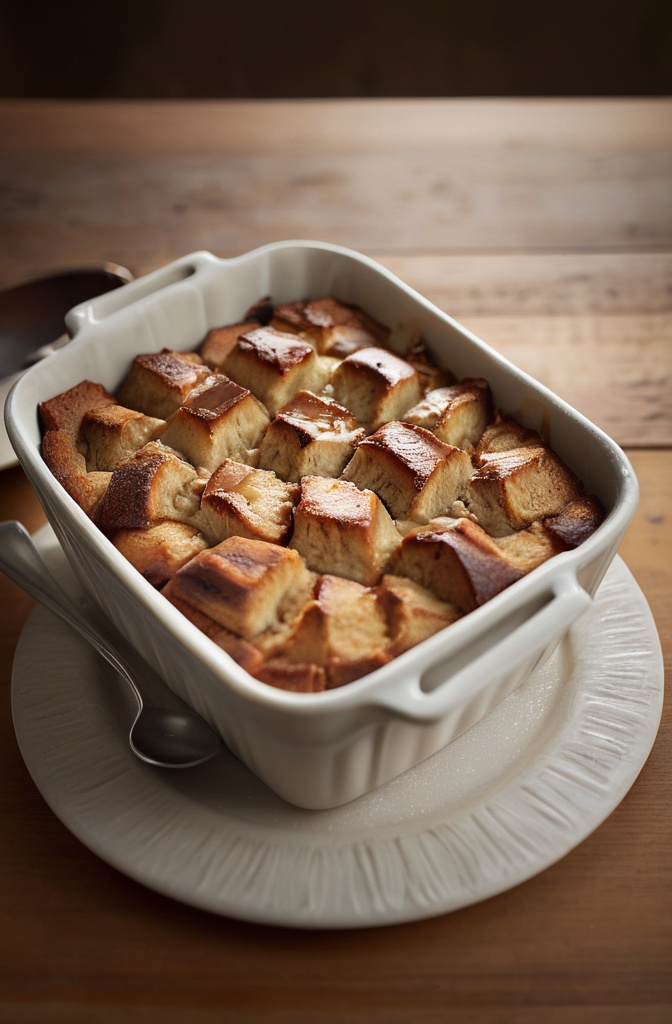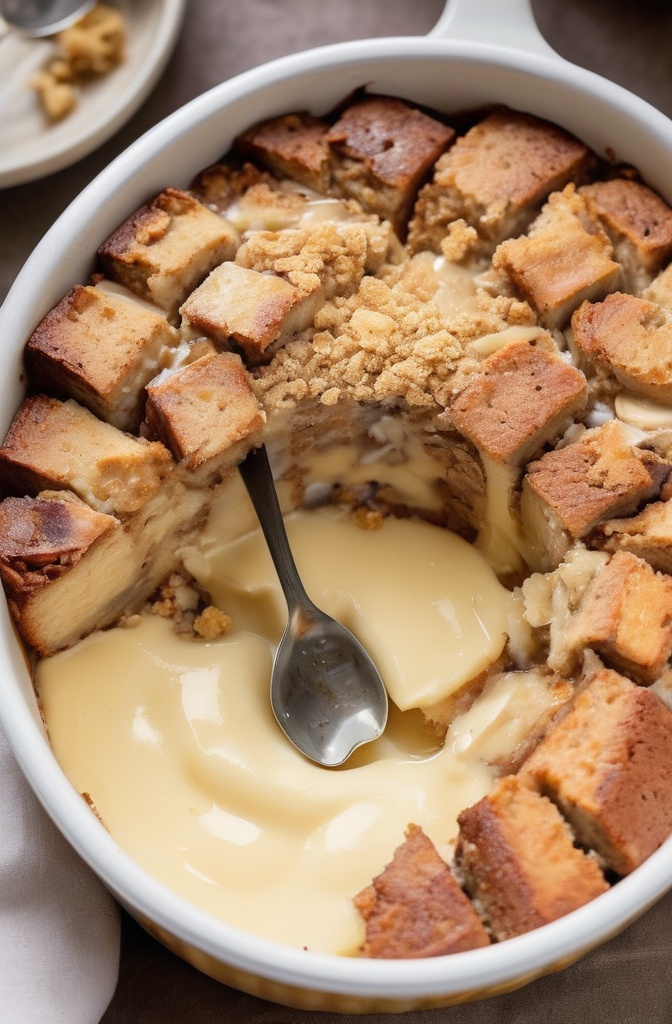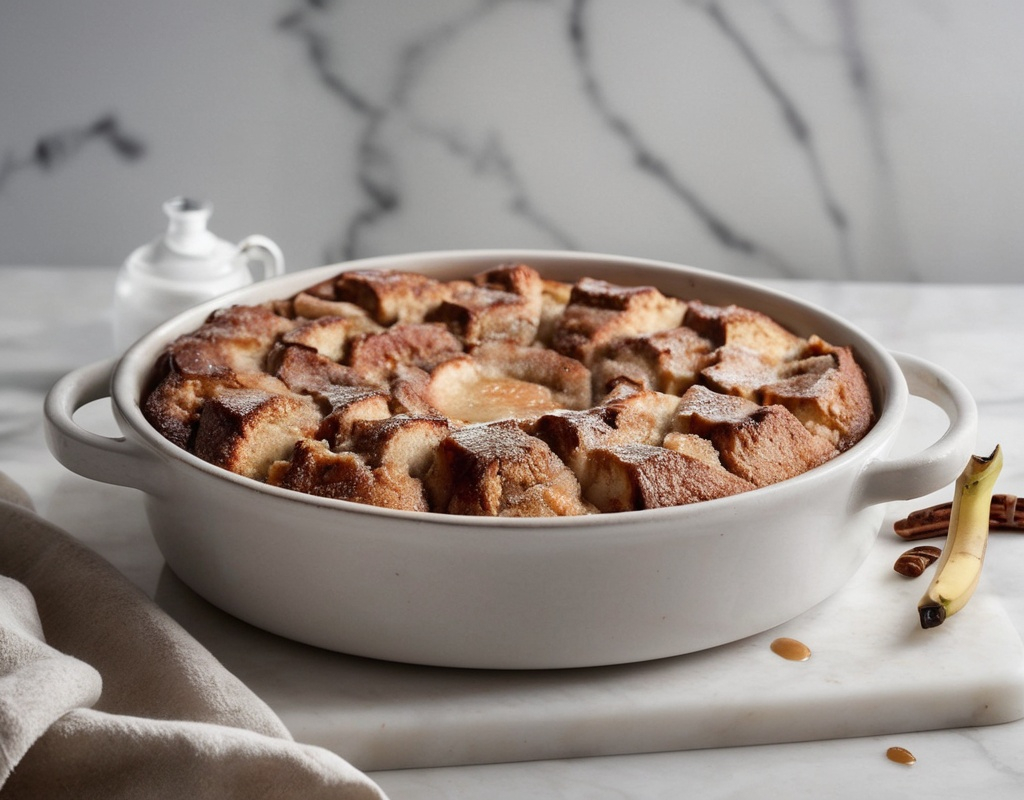Banana bread pudding is not just a dish. It’s a memory baked into custard. Warm, soft, slightly sweet and rich—this is the kind of dessert that speaks in whispers, not shouts. It sneaks onto menus in high-end restaurants and family diners alike, and somehow, it always finds a way to steal the show. And yeah, maybe it’s rustic. Maybe it’s a bit old-school. But in a world chasing the next viral croissant hybrid, banana bread pudding is calmly waiting in the corner… changing everything.
This article dives deep. We’re not just throwing together bananas and bread and hoping for the best. We’re breaking down starch gelatinization, caramelization, even touching on the Maillard reaction. We’re going into the science, the soul, and the subtle artistry that separates a soggy mess from a velvety masterpiece.
The Basics: What Even Is Banana Bread Pudding?
Let’s not confuse this with banana bread or plain bread pudding. Banana bread pudding is a layered dessert that merges overripe bananas, custard (usually eggs, cream, sugar), and stale or toasted bread. It’s baked until golden and slightly puffed, with a custard that sets just enough to hold but stays soft and luscious inside.
The texture is where the magic lies. It’s not cake. It’s not mousse. It’s somewhere hauntingly in between. Like the memory of childhood breakfasts but dressed for dinner service.
Where It Came From: A History Baked in Scraps
Bread pudding, historically, was poor folk food. You didn’t waste bread. That was sacrilege. So when loaves went stale, you cubed them, soaked them in eggs and milk, and baked them into something edible—maybe even delightful.
Banana bread showed up in the 1930s, around the Great Depression. Flour was scarce. Bananas browned faster in homes that didn’t have refrigeration. People found that mashed bananas made baked goods moist without eggs or butter.
It didn’t take long for these two worlds to collide. By the 1970s, banana bread pudding was showing up in Southern cookbooks and family recipe boxes. Not flashy. Not trending. Just good.
Ingredient Selection: Where You Win or Lose the Game
Forget the recipe for a minute. Your ingredients will tell you if your pudding’s gonna sing or slump. Let’s go ingredient-by-ingredient, with expert commentary:
Bananas: Use them dead-ripe. Like, fruit-fly-ripe. You want enzymatic breakdown already in full swing. This boosts sugar content and aroma—both crucial for a good bake. Don’t use underripe bananas unless you want to eat regret.
Bread: Brioche is a top-tier pick. Challah’s also brilliant. But if all you’ve got is stale sourdough or dinner rolls, you can make that work. What matters is structure. Bread should be dry enough to soak up custard without disintegrating.
Custard Base: Whole milk and cream give the best mouthfeel. Eggs should be fresh but not overly large—too many eggs make it taste like French toast gone wrong. A 2:1 milk-to-cream ratio with three eggs per quart is a solid start.
Sweetener: Brown sugar is the soul here. White sugar lacks depth. Molasses-forward dark brown sugar can be too aggressive though. Use light brown sugar unless you really know what you’re doing.
Add-ins: Go easy. Pecans? Sure. Chocolate chips? If you must. But the more you add, the less your bananas get to speak.

Technique Matters More Than You Think
Anyone can dump stuff in a dish and bake it. But we’re here to talk about professional technique.
Toasting the Bread: Crucial. It creates structure, helps avoid mushiness, and develops flavor via the Maillard reaction. Cubes should be toasted in a low oven (around 275°F) until dry and slightly golden. Takes 20–30 mins. Don’t skip this.
Macerating the Bananas: Mash half, slice half. Mix the mashed ones with a bit of brown sugar and cinnamon and let them sit 10–15 mins. This draws out juices and creates a natural syrup.
Custard Infusion: Warm the cream and milk with a split vanilla bean or some citrus zest. Don’t boil it. Just coax the flavor out. Then temper the eggs gently before combining everything.
Soaking Time: Let the bread sit in the custard for at least 30 mins before baking. This ain’t a dump-and-go. Good pudding is soaked through, not just moistened on the outside.
Baking Strategy: Use a water bath (bain-marie) for best results. It keeps the custard from curdling. Bake at 325°F for 45–60 mins depending on thickness. Edges should puff slightly, center should jiggle just a bit.
Banana Bread Pudding in the Restaurant World
Let’s not pretend this is some back-of-the-house throwaway. Banana bread pudding is popping up in Michelin-starred kitchens. Why? Low food cost, high guest satisfaction, and nostalgic appeal.
Chef Nina Compton (Compère Lapin, New Orleans) has a version with rum caramel and banana chips. Dominique Crenn once served a deconstructed bread pudding course. It’s not that the dessert changed—chefs just realized how much you can do with it.
A 2023 National Restaurant Association survey listed “elevated comfort desserts” as a top trend. Banana bread pudding fits that bill like a silk glove.
Emerging Trends and Modern Twists
If you’re looking to innovate, here’s where the train’s heading:
Sous Vide Custard Base: Allows precision cooking and foolproof setting. Combine with pressure-infused banana slices for deeper flavor penetration.
Savory Banana Puddings: This is niche, but wild. Think plantains, caramelized onions, and rosemary custard. It’s divisive. But it’s happening.
Fermented Banana Puree: Adds umami and funk. Used in avant-garde kitchens. Not for the faint of heart—or palate.
Global Influences: Adding cardamom (South Asian), pandan (Southeast Asian), or dulce de leche (Latin American) gives the pudding cultural resonance and complexity.

Common Mistakes Even Pros Still Make
- Using fresh bread. It won’t absorb the custard properly. You’ll get soggy top, dry bottom. No thanks.
- Overbaking. This kills the texture. You want set custard, not rubber.
- Too much sugar. Bananas are already sweet. Overload it and the dish turns cloying fast.
- Ignoring salt. Just a pinch in the custard makes every other flavor sharper and more vivid.
Data Snapshot: Why This Dessert Works
- Banana consumption in the U.S. (2023): 28 pounds per person annually, per USDA.
- Bread waste in commercial kitchens: Estimated 18% of total food waste, according to ReFED.
- Search growth (Google Trends): “Banana bread pudding” spiked 74% globally in 2022–2024, especially in North America and Southeast Asia.
This is a sustainable, low-waste dessert that aligns with global food trends and customer desires. It’s not just about taste anymore—it’s about story, ethics, and nostalgia.
Final Takeaways: How to Elevate Banana Bread Pudding from Meh to Michelin
- Respect your ingredients. If your bananas are meh, your pudding will be too.
- Toast, soak, rest, and don’t rush. Time is a key ingredient, even though it’s not on the list.
- Use a bain-marie. Seriously. Stop baking custards dry. It’s a war crime.
- Customize, but thoughtfully. Let banana be the star. Supporting flavors should whisper, not scream.
Whether you’re a pastry chef in a two-star kitchen or a caterer prepping for 150 covers, banana bread pudding can be your ace. It’s deceptively simple. Emotionally loaded. And if you treat it right? It’s unforgettable.
You just have to stop thinking of it as leftovers. And start treating it like legacy.
FAQs
What is banana bread pudding, exactly?
It’s a dessert made from ripe bananas, custard, and stale or toasted bread, baked until golden with a soft center. Think of it as a cross between banana bread and traditional bread pudding.
Can I use fresh bananas instead of overripe ones?
You can, but overripe bananas offer more flavor and sweetness, making a richer pudding.
What’s the best bread for banana bread pudding?
Brioche or challah work best, but any dry, sturdy bread will do—think sourdough or dinner rolls.
Why do I need to toast the bread first?
Toasting helps the bread absorb custard without becoming soggy and adds a nutty flavor.
Do I really need to use a water bath?
Yes, a water bath ensures the custard cooks evenly and stays smooth without curdling.
How long should I soak the bread in the custard?
At least 30 minutes to allow the bread to fully absorb the custard.
Can I make banana bread pudding ahead of time?
Yes, it can be made in advance and reheated, often tasting better the next day.
Is banana bread pudding considered sustainable?
Yes, it helps reduce food waste by using overripe bananas and stale bread.
How can I modernize or elevate the classic version?
You can add spices, use sous vide, or try global ingredients like pandan or cardamom—but keep banana the focus.
What are the most common mistakes to avoid?
Avoid using fresh bread, overbaking, adding too much sugar, or skipping salt. These will affect texture and flavor.
Is banana bread pudding trending?
Yes, it’s gaining popularity as a nostalgic, sustainable dessert with both home cooks and professionals.

Mariana is a passionate home cook who creates delicious, easy-to-follow recipes for busy people. From energizing breakfasts to satisfying dinners and indulgent desserts, her dishes are designed to fuel both your body and hustle.
When she’s not in the kitchen, she’s exploring new flavors and dreaming up her next recipe to share with the Foodie Hustle community.

